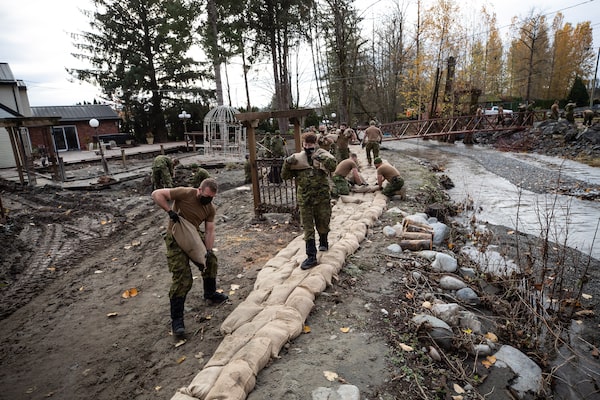
Members of the Canadian Forces build a temporary dike on Nov. 24 with sandbags in Abbotsford, B.C.DARRYL DYCK/The Canadian Press
After more than a decade of fruitless lobbying by local governments, B.C. Premier John Horgan says he is now prepared to fix the system that leaves individual communities shouldering responsibility for flood protection.
Mr. Horgan, responding to a question about dike failures that have led to catastrophic flooding in British Columbia this month, said the decision by the province in 2003 to devolve flood authority was “a bad call,” and he promised that both Canada and B.C. are ready to help fund repairs and upgrades to substandard dikes.
“We need to put provincial and federal dollars in play to protect communities like yours,” he told a reporter from the flood-devastated Fraser Valley during a news conference on Friday evening, “and making sure that we’re not putting the burden of those dollars on the backs of local ratepayers. It’s just not feasible. It wasn’t a decision I would’ve made, but it’s one that I’m obliged and, working with the Prime Minister, intend to fix.”
B.C. communities warned to prepare for more flooding, closed highways as storms return
How the B.C. floods revealed the fragility of Canada’s food system
The B.C. government handed off responsibility for flood control to local governments in 2003, creating a hodgepodge of regimes, hampered by insufficient funds, overlapping jurisdictions and gaps in knowledge and expertise. The system means that in Metro Vancouver alone, there are 21 separate authorities. Each one is responsible for its own flood-control plan and for preparing for climate change within its own areas.
It was an unwelcome shift that the Union of B.C. Municipalities has been protesting against since. Local governments have been passing resolutions – with increasing urgency – asking for help with flood control for at least 15 years.
The province funds some dike upgrades when they meet high-cost seismic standards, but experts have warned that still left communities vulnerable to flooding disasters.
Abbotsford Mayor Henry Braun welcomed Mr. Horgan’s commitment, as his flooded community raced to finish repairing the Sumas dike, which failed during the historic heavy rains that caused catastrophic damage across Southern B.C. two weeks ago.
Mr. Braun met with Prime Minister Justin Trudeau and B.C. deputy Premier Mike Farnworth on Friday afternoon. “I impressed upon them the importance of supporting our critical diking and drainage infrastructure,” he said during a news briefing on Saturday. “Dikes, like highways, are essential components of local infrastructure systems that significantly support multiple cities, and therefore require oversight and support by senior levels of government.”
Prime Minister Justin Trudeau is shown maps by Abbottsford Mayor Henry Braun during a visit to the city after rainstorms lashed the western Canadian province of British Columbia, triggering landslides and floods, and shutting highways, in Abbotsford, B.C.JENNIFER GAUTHIER/Reuters
The mayor added that the impact of a failure of Abbotsford’s flood protection could have devastating and far-reaching implications. “If we are not supported, and the Barrowtown [water] pump station fails, we expect there will be eight feet or more of water over Trans-Canada Highway 1 for months,” he said Saturday, “which could result in a critical transportation route for residents and goods and services for the Lower Mainland and B.C. being out of commission for up to a year.”
At the height of the flooding that came after an extreme rainstorm in mid-November, Abbotsford officials were worried the Barrowtown pump would fail, which would allow water from the Fraser River to flow into the Sumas Prairie, already flooded after the dike was breached.
The pump station held, and on Saturday, the mayor said repairs to the dike, with the assistance of the Canadian Armed Forces, is now 95 per cent complete. But with more heavy weather systems on the way, Abbotsford remained on high alert on Saturday.
The B.C. NDP government has acknowledged the challenges of the current system of flood protection for some time. In 2020, the Environment Ministry began working on a climate change preparedness and adaptation strategy. But a new flood strategy is still in the works.
We have a weekly Western Canada newsletter written by our B.C. and Alberta bureau chiefs, providing a comprehensive package of the news you need to know about the region and its place in the issues facing Canada. Sign up today.
 Justine Hunter
Justine Hunter